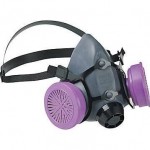 Employees working in environments with insufficient oxygen or where harmful dusts, fogs, smokes, mists, fumes, gases, vapors, or sprays are present, need respirators. These types of hazardous exposures may cause cancer, lung impairment, other diseases, or even death.
Employees working in environments with insufficient oxygen or where harmful dusts, fogs, smokes, mists, fumes, gases, vapors, or sprays are present, need respirators. These types of hazardous exposures may cause cancer, lung impairment, other diseases, or even death.
What has to happen in order for me to use a respirator? The OSHA 1910.134 Respirators standard contains requirements for program administration, worksite-specific procedures, respirator selection, employee training, fit testing, medical evaluation, and respirator use, cleaning, maintenance, and repair. Employees must understand each of these areas as covered in training.
What training is needed to wear a respirator? Employers must develop training programs that are comprehensive enough for the employee to demonstrate a knowledge of the limitations and capabilities for the respirator, why the respirator is necessary, and how improper fit, usage, or maintenance can compromise the respirator. Training must include an explanation of:
- Why respirator use is necessary.
- Nature of the respiratory hazard and consequences of not fitting, using, and maintaining the respirator properly.
- Reason(s) for selecting a particular type of respirator.
- Capabilities and limitations of the selected respirator.
- How to inspect, put on and remove, and check the seals of the respirator.
- Respirator maintenance and storage requirements.
- How to use the respirator effectively in emergency situations, including when the respirator malfunctions.
- How to recognize medical signs and symptoms that may limit or prevent the effective use of the respirator.
What are the differences in the respirators? Employers must consider the chemical and physical properties of the contaminant, as well as the toxicity and concentration of the hazardous material and the amount of oxygen present. Other selection factors are nature and extent of the hazard, work rate, area to be covered, mobility, work requirements and conditions, as well as the limitations and characteristics of the available respirators. Air-purifying respirators use filters or sorbents to remove harmful substances from the air. They range from simple disposable masks to sophisticated devices. They do not supply oxygen and must not be used in oxygen-deficient atmospheres or in other atmospheres that are immediately dangerous to life or health (IDLH).
Atmosphere-supplying respirators are designed to provide breathable air from a clean air source other than the surrounding contaminated work atmosphere. They include supplied-air respirators (SARs) and self-contained breathing apparatus (SCBA) units. These are the only types of atmospheres capable of being used in lower oxygen or toxic atmospheres. Both of these types have limitations and also extensive training requirements for employees to use as the worker is in a toxic atmosphere and is reliant on the air supplied to them.
